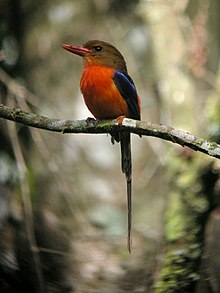
Brightly colored birds of the order Coraciiformes. They are a cosmopolitan species with the majority of their species being found in tropical regions in Africa, Asia and Oceania. However, they can also be found in Europe. They are found in dense forests, near small rivers and calm ponds. There are 114 species in the family. It is divided into three families and 19 genera.
Kingfishers share a large head, large, pointed, pointed bill, and short, stubby tails. The majority of species have bright plumage, with very few differences among the sexes. The majority of species are found in tropical areas, with a few exceptions being restricted to forests. They eat a variety of prey, usually by diving down from perches.
Kingfishers live near rivers, and are thought to eat fish. However, there are many species that live far from water and eat small insects. They nest in cavities like other members of the order. Usually, these tunnels are dug into natural or artificial soil banks. Kingfishers can nest in arboreal termite colonies. Some species are endangered with extinction, mainly insular ones. The common Kingfisher is the most commonly used word for “kingfisher” in Britain.
Taxonomy and systematics of evolution
Alcedinidae, the kingfisher family, is part of the Coraciiformes order.[2][3][7] Many of these birds, despite the use of the term “kingfisher” as their English names, are not specialists fish-eaters. None of the species in Halcyoninae, are. White Birds The Australasian realm is the centre of kingfisher biodiversity. However, the group originated in Indomalayan around 27 million years old and has since invaded Australasia several times.
The Miocene rocks in Australia, which are between 5 and 25 million years old, have more recent fossil kingfishers. Many fossil birds have been incorrectly attributed to the kingfishers. Halcyornis from the Lower Eocene rock in Kent was also considered a gull but it is now believed to be a member an extinct family.
Description
The African dwarf kingfisher, also known as Ispidina lecontei, is the smallest species. Its average length is 10 cm (3.9 in). Its weight is between 9 and 12 grams (0.32 to 0.42 oz).Most kingfishers have bright plumage. The most common colours are green and blue. The bright colours are not due to iridescence (except in American kingfishers), or pigments. However, when they do occur, they are very small (less than 10 10).
Kingfishers have long, dagger-like bill. The bill is typically shorter and less compressed for species that hunt fish and longer and wider for species that hunt prey from the ground. The shovel-billed Kookaburra is the largest and most unusual bill. It is used to search for prey on the forest floor. Although they have shorter legs, species that feed on the ground tend to have longer tarsi. The majority of species have four toes. Three of them are forward-pointing.
Most species have dark brown iris. Kingfishers are able to see well, and can even binocular view. They also have good colour vision. Their eyes are restricted to movement within the sockets of their eyes. Instead, they use head movements to track prey. They are also capable of compensating the reflections and refractions of water when hunting prey under water. To protect their eyes from the water, they have nictitating membranes. The pied Kingfisher has an eye plate that slides across the eye when it touches the water.
Habitat and distribution
Kingfishers are found in all parts of the globe’s tropical and temperate zones. They are not found in the polar regions or the deserts of the world. Many species have made it to islands, especially in the east and south Pacific Oceans. This group is centered in the Old World Tropics and Australasia. Europe and North America north from Mexico are poorly represented with only one common monarchfisher ( commonbelted kingfisher). The Gambia, an African country, has eight species within its 120-by-20 mile (193 by 32km) area.